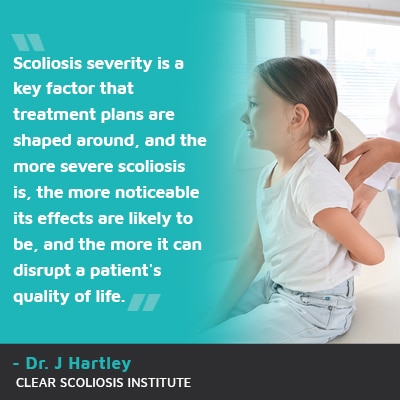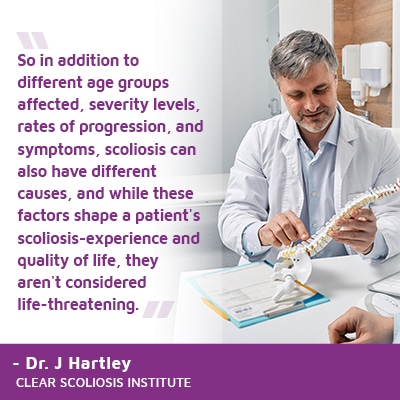
Scoliosis causes the spine to bend unnaturally to the side and rotate, but it's not considered a life-threatening condition. There are no treatment guarantees, but many cases of scoliosis respond well to a combination of nonsurgical treatment options, and early detection and intervention are associated with successful treatment outcomes.
Scoliosis is a spinal condition that causes a loss of its healthy curves, and while it can be serious and requires treatment, it's not fatal. What scoliosis can do, particularly if left untreated or not treated proactively, is impact quality of life, but when proactively addressed, it can be highly treatable.
No two cases of scoliosis are the same, so let's discuss the factors that can vary from patient to patient, starting with condition severity.
Scoliosis is a progressive spinal condition, so the nature of the unhealthy spinal curvature is to increase in size over time, ranging from mild scoliosis to moderate and severe scoliosis.
Scoliosis progression is triggered by growth, so childhood scoliosis, in particular, needs to be taken seriously and treated proactively.
Not only does scoliosis range widely in severity, it can also progress at different rates.
Children with growth occurring are facing the constant trigger of progression, and while progression tends to slow in adults who have reached skeletal maturity, they can still progress, and when age-related spinal degeneration starts, progression can occur quickly as the spine becomes increasingly unbalanced and unstable.
Part of a patient's initial assessment involves gauging how much potential growth a patient has yet to go through so treatment plans can focus on managing progression.
Scoliosis that's diagnosed as mild doesn't mean it will stay mild; only proactive treatment can work towards counteracting progression.
There are different approaches to scoliosis treatment, and it’s important for patients to understand the differences so they can make informed treatment choices; the way scoliosis is treated can shape the spine’s long-term health.

Scoliosis can affect the body in different ways. Although it's a spinal condition, because of how spinal health is linked to overall health, an unnatural spinal curvature can affect the spine, its surroundings, and the entire body.
As an asymmetrical condition, the main visual effect of scoliosis is its ability to disrupt the body's overall symmetry through postural changes.
The health of the spine can shape posture, and vice versa, so one of the earliest signs of scoliosis in children involves postural changes such as uneven shoulders and uneven hips.
If progression is occurring, postural changes become more overt and can include uneven shoulder blades, the development of a rib cage arch, arm and leg length discrepancies, and changes to movement are also common.
A patient's initial assessment will include a posture and mobility assessment as a patient's posture and gait are prime indicators of spinal health.
Scoliosis can also change the way a person walks, and disruptions to balance and coordination are also common.
There are also the mental health effects that can’t be discounted. Particularly in the condition’s most-prevalent type, adolescent scoliosis, we’re talking about an age group known to struggle with mental health, known for negative body issues, and known to be affected by image.
Being diagnosed with a progressive spinal condition that can change the way a teenager looks, walks, and moves can be devastating.
In addition, certain cases can come with activity restrictions, so imagine how disruptive a collision-sport restriction can be to a high school football star.
In adult scoliosis, postural and movement changes are common effects, including a noticeable lean to one side, but while postural changes are the earliest symptoms of childhood scoliosis, it's pain that brings most adults in for assessment and diagnosis.
Scoliosis isn't always painful, particularly for children as scoliosis becomes compressive once skeletal maturity has been reached.
While children can still experience degrees of back and muscle pain caused by their scoliosis, pain isn't considered a common symptom of childhood scoliosis, but back pain and pain that radiates into the extremities due to nerve compression characterizes adult scoliosis.
Muscle pain is also common as a common effect of scoliosis is a muscular imbalance as the muscles that surround the spine are pulled in opposing directions; muscles on one side of the spine have to work harder to counteract the spine's unnatural bend and twist, while muscles on the opposite side can become weak from lack of use.
For patients experiencing scoliosis pain, it can range from mild and intermittent to chronic and debilitating; the best way to manage scoliosis pain is to treat the scoliosis proactively, and the sooner treatment is started, the better.
In addition to different severity levels, rates of progression, and condition effects, there are also different types of scoliosis to consider: some more severe than others.
Because no two cases of scoliosis are the same, treatment plans need to be fully customized to address the specifics of each patient's body and scoliosis type.
The main type of scoliosis overall is idiopathic scoliosis, meaning not clearly associated with a single-known cause, and the most prevalent form of scoliosis overall is adolescent idiopathic scoliosis affecting adolescents between the ages of 10 and 18.
Approximately 80 percent of known cases are classified as idiopathic scoliosis, but the remaining 20 percent are associated with known causes and can be particularly severe: neuromuscular scoliosis, degenerative scoliosis, and congenital scoliosis.
My neuromuscular scoliosis patients can be the most challenging to treat, and this is because the scoliosis develops as a secondary complication of a serious neuromuscular condition such as spina bifida, cerebral palsy, or muscular dystrophy.
Although severe and atypical, neuromuscular scoliosis isn't considered a life threatening condition, but it can greatly disrupt a patient's quality of life, particularly when/if patients become unable to walk on their own and wheelchair-bound.
In cases of neuromuscular scoliosis, the underlying neuromuscular condition has to be the focus of treatment.
Degenerative scoliosis cases also tend to be severe because they affect older adults experiencing spinal degeneration, and as it's caused by degenerative instability, fall prevention is a focus of treatment, and almost all cases are going to be painful and progressive.

Can scoliosis kill you? No, scoliosis isn't considered a life-threatening condition, but if severe and/or if left untreated, it can cause complications capable of disrupting quality of life.
As a progressive condition, scoliosis is ongoing, but it can be highly treatable; in fact, there are a number of professional athletes and celebrities who have fulfilled their life's ambitions despite an earlier scoliosis diagnosis.
Here at the CLEAR Scoliosis Institute, the focus is on securing the best possible treatment outcome for the patient, and restoring the spine's healthy curves and alignment can improve the entire body's balance and stability.
Through a combination of scoliosis-specific chiropractic care, physical therapy, and corrective bracing, scoliosis can be impacted on many levels; from altering the spine's position and alignment to increasing spinal support/stability through improving the balance and strength of its surrounding muscles, conservative scoliosis treatment is evidence-based and patient-centered.

CLEAR provides a unique and innovative way of understanding scoliosis. Sign up to receive facts and information you won’t find anywhere else.
